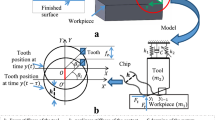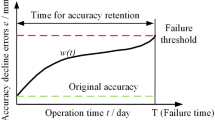Abstract
In advanced manufacturing, tool point frequency response function (FRF) is the most extensive requirement in avoiding the unstable condition of a machine tool, especially in generating a stability lobe diagram which is widely used in predicting the milling stability for chatter avoidance. However, compared with the analytical method that uses a Euler-Bernoulli beam model for calculating the tool point FRF, the analysis based on a Timoshenko beam model mathematically or analytically is seldom provided. Experimental validation is also not sufficient. In this paper, an approach of tool point frequency response prediction based on Timoshenko beam model is presented, using receptance coupling substructure analysis. This approach employs the combination of experimental result and numerical beam analysis. The proposed receptance calculate theory allows to better estimate the matrix of receptance related to rotation. Based on this theory, an unknown tool point FRF can be predicted by an already known tool point FRF. In the meantime, no additional experiment is required after a single experiment to compute tool holder frequency response. Prediction method has been verified by experiments. The results show the effectiveness and reliability of the proposed method in tool point frequency prediction and effective manufacturing.
Similar content being viewed by others
Reference
Taylor FW (1907) On the art of cutting metals. American society of mechanical engineers, New York
Tobias SA, Fishwick W (1958) Theory of regenerative machine tool chatter. Eng 205:199–203
Tlusty J, Polacek M (1963) The stability of machine tools against self-excited vibrations in machining. Int Res Prod Eng 1:465–474
Merritt HE (1965) Theory of self-excited machine-tool chatter: contribution to machine-tool chatter research—. J Eng Ind 87:447–454
Altintaş Y, Budak E (1995) Analytical prediction of stability lobes in milling. CIRP Ann Technol 44:357–362
Geng Z, Ridgway K, Turner S (2007) Linear improvement of the machining stability lobes and application in milling process prediction. Proc Inst Mech Eng Part B J Eng Manuf 221:369–378
Insperger T, Stépán G (2004) Updated semi-discretization method for periodic delay-differential equations with discrete delay. Int J Numer Methods Eng 61:117–141
Ding Y, Zhu L, Zhang X, Ding H (2010) A full-discretization method for prediction of milling stability. Int J Mach Tools Manuf 50:502–509
Cai H, Mao X, Li B, Luo B (2015) Estimation of FRFs of machine tools in output-only modal analysis. Int J Adv Manuf Technol 77:117–130
Guo Q, Sun Y, Jiang Y, et al (2016) Determination of the stability lobes with multi-delays considering cutter’s helix angle effect for machining process. Proc Inst Mech Eng Part B J Eng Manuf. doi:10.1177/0954405415623480
Schmitz TL, Donalson RR (2000) Predicting high-speed machining dynamics by substructure analysis. CIRP Ann Technol 49:303–308
Schmitz TL, Davies MA, Kennedy MD (2001) Tool point frequency response prediction for high-speed machining by RCSA. J Manuf Sci Eng 123:700–707
Schmitz TL, Davies MA, Medicus K, Snyder J (2001) Improving high-speed machining material removal rates by rapid dynamic analysis. CIRP Ann Technol 50:263–268
Schmitz TL, Duncan GS (2005) Three-component receptance coupling substructure analysis for tool point dynamics prediction. J Manuf Sci Eng 127:781–790
Schmitz TL, Duncan GS (2006) Receptance coupling for dynamics prediction of assemblies with coincident neutral axes. J Sound Vib 289:1045–1065
Kumar UV, Schmitz TL (2012) Spindle dynamics identification for receptance coupling substructure analysis. Precis Eng 36:435–443
Medicus KM, Schmitz TL (2001) Evaluating the tool point dynamic repeatability for high-speed machining applications. In: Proc. 16th Annu. ASPE Meet. 19:357–360
Park SS, Altintas Y, Movahhedy M (2003) Receptance coupling for end mills. Int J Mach Tools Manuf 43:889–896
Park SS, Chae J (2008) Joint identification of modular tools using a novel receptance coupling method. Int J Adv Manuf Technol 35:1251–1262
Fu Q, Rashid A (2015) Joint interface characterization method using frequency response measurements on assembled structures only: theoretical development and experimental validation on a workholding fixture for machining. Int J Adv Manuf Technol 77:1213–1228
Ahmadian H, Nourmohammadi M (2010) Tool point dynamics prediction by a three-component model utilizing distributed joint interfaces. Int J Mach Tools Manuf 50:998–1005
Albertelli P, Cau N, Bianchi G, Monno M (2012) The effects of dynamic interaction between machine tool subsystems on cutting process stability. Int J Adv Manuf Technol 58:923–932
Xu C, Zhang J, Wu Z et al (2013) Dynamic modeling and parameters identification of a spindle–holder taper joint. Int J Adv Manuf Technol 67:1517–1525
Tang X, Peng F, Yan R, et al (2016) An effective time domain model for milling stability prediction simultaneously considering multiple modes and cross-frequency response function effect. Int J Adv Manuf Technol 86:1037–1054. doi:10.1007/s00170-015-8129-4
Ertürk A, Özgüven HN, Budak E (2006) Analytical modeling of spindle–tool dynamics on machine tools using Timoshenko beam model and receptance coupling for the prediction of tool point FRF. Int J Mach Tools Manuf 46:1901–1912
Ertürk A, Özgüven HN, Budak E (2007) Effect analysis of bearing and interface dynamics on tool point FRF for chatter stability in machine tools by using a new analytical model for spindle–tool assemblies. Int J Mach Tools Manuf 47:23–32
Ertürk A, Budak E, Özgüven HN (2007) Selection of design and operational parameters in spindle–holder–tool assemblies for maximum chatter stability by using a new analytical model. Int J Mach Tools Manuf 47:1401–1409
Korayem MH, Shafei AM, Absalan F et al (2014) Kinematic and dynamic modeling of viscoelastic robotic manipulators using Timoshenko beam theory: theory and experiment. Int J Adv Manuf Technol 71:1005–1018
Loudini M (2010) Timoshenko beam theory based dynamic modeling of lightweight flexible link robotic manipulators. In: advances in robot manipulators. InTech, Croatia, pp 625–651
Zu JW-Z, Han RPS (1992) Natural frequencies and normal modes of a spinning Timoshenko beam with general boundary conditions. J Appl Mech 59:S197–S204
Aristizabal-Ochoa JD (2004) Timoshenko beam-column with generalized end conditions and nonclassical modes of vibration of shear beams. J Eng Mech 130:1151–1159
Bishop RED, Johnson DC (2011) The mechanics of vibration. Cambridge University Press, New York
Timoshenko S, Gere JM (1972) Mechanics of materials. McGraw-Hill, New York
Schmitz TL, Smith KS (2008) Machining dynamics: frequency response to improved productivity. Springer, New York
Meyers MA, Chawla KK (2009) Mechanical behavior of materials. Cambridge university press, Cambridge
Author information
Authors and Affiliations
Corresponding author
Rights and permissions
About this article
Cite this article
Qi, B., Sun, Y. & Li, Z. Tool point frequency response function prediction using RCSA based on Timoshenko beam model. Int J Adv Manuf Technol 92, 2787–2799 (2017). https://doi.org/10.1007/s00170-017-0236-y
Received:
Accepted:
Published:
Issue Date:
DOI: https://doi.org/10.1007/s00170-017-0236-y




